嵌段聚合物熔体高斯模型
使用Monte Carlo方法观察受限状态下嵌段聚合物自组装结构-高分子物理-实验5-05

实验五使用Monte Carlo方法观察受限状态下嵌段聚合物自组装结构一、实验目的1.了解Monte Carlo方法模拟聚合物自组装的基本原理2.观察在受限状态下,聚合物自组装过程二、实验原理嵌段共聚物是由化学性质不同的、两个或两个以上的链段,通过化学键相连接而组成的高分子体系。
不同链段之间由于性质不同而相互排斥,导致体系在熔融状态下或者溶液中发生相分离。
由于各嵌段之间由共价键相连,体系的相分离只能发生在微观的链段尺度上。
这种微观尺度的相分离形成的自组装结构尺寸在10 ~ 100纳米之间,它们可以应用于各种纳米器件的制备如微反应器、磁性介质存储等领域,有着广泛的应用前景。
通过细致的研究,人们已经得出这样的结论:这些纳米结构的形成主要是依赖于嵌段共聚物的各种分子参数,例如:分子链内各组分的化学物理特性,不同嵌段间的相互作用,以及分子链的结构性质。
此外,人们通过研究还发现,自组装体系的环境通过对自组装过程的限制可以影响聚合物体系最终的自组装结构。
这一现象表明,人们或许可以通过调控外界环境从而制备新型的纳米结构材料。
在受限状态下,嵌段聚合物与环境界面间的相互作用、环境限制的几何形状和尺度都会影响聚合物自组装的过程。
例如,对称的二嵌段共聚物在本体熔融状态下会自组装形成层状结构。
当这种对称的二嵌段共聚物在硬质平行板间进行自组装时,如果板间距与聚合物自身的层状周期不相容,聚合物的周期结构就会发生改变,从而偏离本体时的稳定结构。
研究者们发现在这一过程中,如果平行板对不同的嵌段有不同的作用,体系就会出现板壁诱导形成的独特结构。
Monte Carlo方法在数学上称其为随机模拟(random simulation)方法,随机抽样(random sampling)技术或统计实验(statistical testing)方法。
它的基本思想是:为了求解数学、物理、几何、化学等问题,建立一个概率模型或随机过程,使它的参数等于问题的解;当所解的问题本身属随机性问题时,则可采用直接模拟法,即根据实际物理情况的概率法来构造Monte Carlo模型;然后通过对模型,或过程的观察,或抽样实验来计算所求参数的统计特征,最后给出所求解的近似值。
D-IL-002-嵌段共聚物自组装理论与模拟研究-梁好均

嵌段共聚物自组装理论与模拟研究梁好均陈鹏李学进中国科学技术大学高分子科学与工程系,合肥 230026;合肥微尺度物质科学国家实验室,合肥 230026,E_mail:hjliang@ 关键词:嵌段共聚物,自组装,自洽场方法,耗散粒子动力学,球内受限嵌段共聚物在不同的条件下自组装形成不同形态的聚集体,已经成为一个热门研究课题,不仅是因为嵌段共聚物自组装的有序结构在学术研究上有重要意义,它在环境、能源、新材料、生命科学、医学和药物等前沿领域也有着广泛的应用前景。
我们课题组用自洽场方法研究了两嵌段共聚物在受限条件下的自组装结构以及用耗散粒子动力学方法研究了三嵌段共聚物在稀溶液中的自组装行为。
由于不同组分之间的不相容性,嵌段聚合物在熔融状态时将发生相分离。
然而,各嵌段之间以化学键相连,故嵌段聚合物不同于共混物那样发生宏观上的相分离,而是发生介观尺寸上的相分离,从而自组装成各种有序的形貌。
通过改变各嵌段单元之间相互作用、各嵌段构成比例以及体系的外界环境,可以设计一系列特殊的纳米结构。
[1-3]嵌段聚合物在平行板间的相行为的研究,已经揭示了通过外界环境诱导聚合物相分离,形成结构新颖的纳米材料的可能性。
[4-7]我们使用自洽平均场理论的方法研究了在本体呈柱状结构的两嵌段共聚物体系,受限在三维球内时的自组装结构。
自洽场方法是基于平均场理论发展而来的,它考虑了高分子链的构型特点和细节特征,如不同单元见的相互作用参数,特征链长等,因此非常适用于描述高分子复杂流体热力学相行为的研究。
我们采用了Fredrickson和Drolet等人提出的实空间方法。
[7-9]我们研究的体系为AB两嵌段共聚物体系,其中A嵌段的体积比例为f A = 0.25,A、B两组分间相互作用参数χN = 25。
在本体状态下,该体系形成六角排列的柱状结构,相邻柱状结构间距L = 3.86Rg。
Rg为研究体系的分子链回转半径。
我们研究的受限结构是一个内径为D的空心硬质球壳,聚合物体系被限制在封闭的球腔内进行自组装。
聚合物形态学
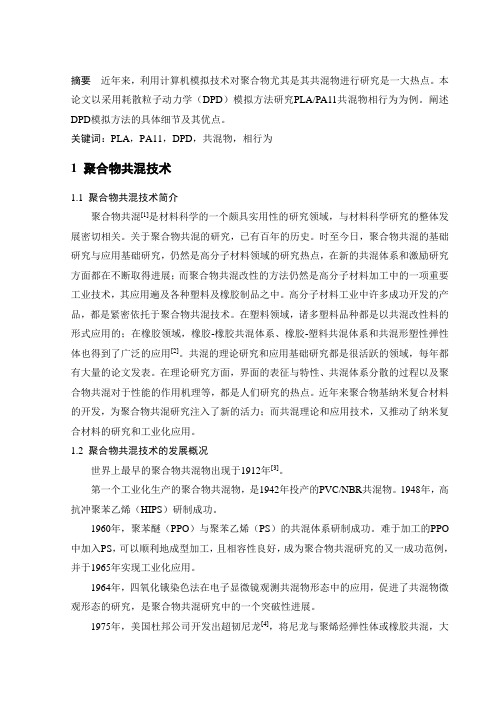
摘要近年来,利用计算机模拟技术对聚合物尤其是其共混物进行研究是一大热点。
本论文以采用耗散粒子动力学(DPD)模拟方法研究PLA/PA11共混物相行为为例。
阐述DPD模拟方法的具体细节及其优点。
关键词:PLA,PA11,DPD,共混物,相行为1 聚合物共混技术1.1 聚合物共混技术简介聚合物共混[1]是材料科学的一个颇具实用性的研究领域,与材料科学研究的整体发展密切相关。
关于聚合物共混的研究,已有百年的历史。
时至今日,聚合物共混的基础研究与应用基础研究,仍然是高分子材料领域的研究热点,在新的共混体系和激励研究方面都在不断取得进展;而聚合物共混改性的方法仍然是高分子材料加工中的一项重要工业技术,其应用遍及各种塑料及橡胶制品之中。
高分子材料工业中许多成功开发的产品,都是紧密依托于聚合物共混技术。
在塑料领域,诸多塑料品种都是以共混改性料的形式应用的;在橡胶领域,橡胶-橡胶共混体系、橡胶-塑料共混体系和共混形塑性弹性体也得到了广泛的应用[2]。
共混的理论研究和应用基础研究都是很活跃的领域,每年都有大量的论文发表。
在理论研究方面,界面的表征与特性、共混体系分散的过程以及聚合物共混对于性能的作用机理等,都是人们研究的热点。
近年来聚合物基纳米复合材料的开发,为聚合物共混研究注入了新的活力;而共混理论和应用技术,又推动了纳米复合材料的研究和工业化应用。
1.2 聚合物共混技术的发展概况世界上最早的聚合物共混物出现于1912年[3]。
第一个工业化生产的聚合物共混物,是1942年投产的PVC/NBR共混物。
1948年,高抗冲聚苯乙烯(HIPS)研制成功。
1960年,聚苯醚(PPO)与聚苯乙烯(PS)的共混体系研制成功。
难于加工的PPO 中加入PS,可以顺利地成型加工,且相容性良好,成为聚合物共混研究的又一成功范例,并于1965年实现工业化应用。
1964年,四氧化锇染色法在电子显微镜观测共混物形态中的应用,促进了共混物微观形态的研究,是聚合物共混研究中的一个突破性进展。
非晶态与取向态液晶态与织态结构
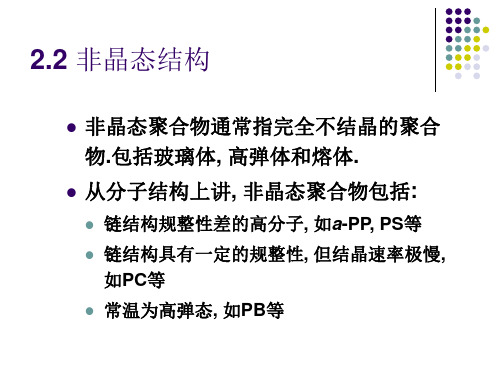
液晶基元包括棒状(条状)、盘状或双亲性分 子
棒状(或条状) 盘状 双亲性分子
长径比大于4 轴比小于1/4 有特殊的相互作用力
C5H11
2nm
CN
5CB C18oN36oI
2.5nm
0.5nm
C H 3 O
C HN
C 4 H 9
MBBA C22oN47oI
R
R
R R
R R
R= H2n+1Cn CO O H2n+1Cn O H2n+1Cn O
选定取向单元(例如高分子主链轴、高聚物结晶主 轴),然后选择取向度的参考方向,如拉伸方向。用 广角X射线衍射仪获取样品的衍射图,取赤道线上 Debye环(常用最强环)的强度分布曲线的半高宽 (单位为“度”),计算聚合物样品中高分子链及微 晶体的取向度:
式中,Π为聚合物样品中高分子链及微晶体沿样品 被拉伸方向的取向度,H°为赤道线上Debye环强度 分布曲线的半高宽度。Π值没有明确物理意义,只能 做相对比较的参考数据。
(2)双折射法表征纤维的取向度
用偏光显微镜观测浸于油中的纤维。“浸油”是已知折光指数的 油剂。变换不同折光指数的油剂浸泡纤维并置于偏光显微镜上进 行观测,直至偏光显微镜目镜中不再出现纤维和浸油界面因折射 率不同而出现的黑线带(贝克线)为止。此时,浸油的折光指数 就是纤维在某一个方向的折光指数(例称为n││)。旋转载物台90 度,用同样的方法测定纤维垂直于前一方向的折光指数(例称为 n┴)。纤维在二个相互垂直方向折光指数的差值Δn,可以用来定 性表 该纤维的取向度。
取向对性能的影响
( the effect of orientation on polylmer properties) 高分子材料取向后,拉伸强度、伸长率、疲劳强度大
高分子物理

一、高分子链的近程结构构造:分子链中原子的种类和排列,包括取代基和端基的种类,结构单元的排列顺序,支链的类型和长度等。
构型:某一原子的取代基在空间的排列。
构像:具有一定组成和构型的高分子链通过单键的内旋转而形成的分子中的原子在空间的排列。
按高分子链化学组成不同可将高聚物分为:碳链高分子(优良的可塑性,主链不易水解)、杂链高分子(有极性,易于水解醇解或酸解)、元素高分子(有特殊性质)、其它高分子(较高的热稳定性)。
键接结构是指结构单元在高分子链中的连接方式。
这种由结构单元间的连接方式不同所产生的异构体称为顺序异构。
变换高聚物(或奇异高聚物):结构单元和单体不相似的高聚物。
旋光异构体:对于不对称C原子构成的化合物,它能构成互为镜影的两种异构体,表现出不同的旋光性。
等规度:高聚物中含有全同立构和间同立构的总百分数。
几何异构体:双键上的基团在双键两侧的排列方式存在顺式和反式两种构型,这种异构体称为几何异构体。
构型的测定方法:X射线衍射,核磁共振,红外光谱法。
支化:线形分子链上延伸出或短或长的分支结构。
支化度:以支化点密度或两相邻支化点之间的链平均分子量来表示支化的程度。
交联:通过化学反应把高分子链用共价键相连接起来,产生网状体型结构。
交联点密度:交联的结构单元占总结构单元的比例,即每一结构单元的交联概率。
共聚物:两种以上单体单元所组成的高聚物。
序列:同类单体直接相连的嵌段。
热塑性弹性体:又称热塑性橡胶,是一类常温下显示橡胶弹性,高温下又能塑化成型的合成材料,是一类兼有橡胶和热塑性塑料特性的强韧性高聚物。
互穿网络高聚物:由两种不同单体各自聚合形成的网络互相贯穿。
半互穿网络高聚物:一线性高聚物在另一高聚物网络形成时均匀分散在其中,宏观上成为一整体者。
二、高分子链的远程结构链段:高分子链中作协同运动的一段链,是高分子链中的独立运动单元。
内旋转:高分子链中C-C单键绕键轴旋转。
柔顺性:高分子链能够改变其构象的性质。
棒-棒二嵌段共聚物熔体的层状和Zigzag层状相结构的动力学演化过程
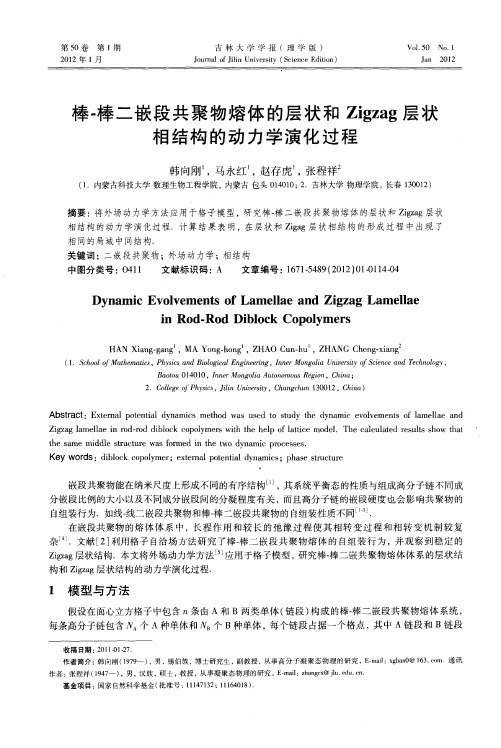
构 和 Zga i g层状结 构 的动力 学演化 过程 . z
1 ห้องสมุดไป่ตู้ 型 与 方 法
假设在面心立方格子中包含 n 条由 A和 B两类单体 ( 链段 ) 构成的棒- 棒二嵌段共聚物熔体系统 , 每条高分子链包含 Ⅳ 个 A种单体和 Ⅳ 个 B种单体 , 每个链段 占据一个格点 , 其中 A链段和 B链段
嵌 段共 聚物 能在 纳米尺 度上形 成 不 同的有序 结构 ¨ , 系统平 衡态 的性质 与组 成高 分子 链不 同成 j其 分嵌 段 比例 的大 小 以及不 同成分嵌 段 问的分凝 程 度有关 ,而且高分 子链 的嵌 段硬 度也 会 影 响共 聚物 的
自组装行为. 如线一 线二嵌段共聚物和棒一 棒二嵌段共聚物的自 组装性质不 同¨ 。.
韩 向刚 马永红 赵存虎 张程祥 , , ,
( .内蒙古科技大学 数理生物工程 学院 ,内蒙古 包头 0 4 1 ; .吉林大学 物理学院 , 1 10 0 2 长春 10 1 ) 3 02
摘要 :将外 场动 力学 方法应用 于格 子模 型 ,研 究棒一 二嵌 段共 聚物熔 体 的层 状和 Zga 棒 i g层状 z 相 结构 的动力 学演 化过程 .计 算 结果 表 明,在 层 状和 Zgg层状 相 结构 的形 成过 程 中 出现 了 i a 相 同 的局 域 中间结构 . 关键 词 :二嵌 段共 聚物 ;外 场动 力学 ;相 结构
第一章__高分子链的结构 011022

第一章高分子链的结构10学时概述§1.1 高分子链的近程结构高分子链的化学结构高分子链的立体化学结构§1.2 高分子链的远程结构高分子链的构象与柔顺性高分子链构象的统计理论和柔性的定量描述掌握内容:1、高分子结构特点、各层次结构的主要内容及链结构与性能的关系2、构象、构型、柔顺性和链段等基本概念及定量描述3、影响柔顺性的因素,并能根据分子结构判断柔顺性的大小理解内容:1、几何算法、高斯统计法计算几种均方末端距的假设、计算过程2、静态柔顺性与动态柔顺性概述1 高聚物的特点:①分子量很大。
比小分子高出好几个数量级。
②链式结构:由很大数目的结构单元(103-105)以共价键相连接而构成。
③链的柔顺性:主链有一定的内旋转自由度,并由于热运动,链的形状可以不断改变。
(产生非常多的构象:DP=100的PE,构象数1094。
)④分子量和分子尺寸的多分散性。
各个分子的分子量和结构都存在或多或少地差异。
所以,高分子的分子量和分子尺寸只能是某种意义上的统计平均值。
我们只能通过某种测量手段知道这种统计平均值。
⑤由于分子量很大,所以分子间的相互作用对凝聚态结构和物理性能有着重要影响。
⑥物质结构的多层次性。
如链结构、凝聚态结构、织态结构等许多层次。
凝聚态的有序程度变化很大,依赖于加工条件。
2. 高分子结构的层次:物质的结构:指在平衡态分子中原子之间或平衡态分子间在空间的几何排列。
Short-range structure(1)高分子链的近程结构:又称化学结构或一级结构,指的是单个分子的结构和形态,它研究的是单个分子链中原子或基团的几何排列情况。
近程结构研究的范围为高分子的构造和构型。
指的是单个高分子内结构单元的化学结构(构造)和立体化学结构(构型)。
Long-range structure(2)高分子链的远程结构:又称二级结构。
研究的是分子的大小和形态,链的柔顺性和分子的构象。
例如:是伸直链、无规线团还是折叠链、螺旋链等。
二嵌段共聚物自组装及高分子链凝聚特性的研究的开题报告
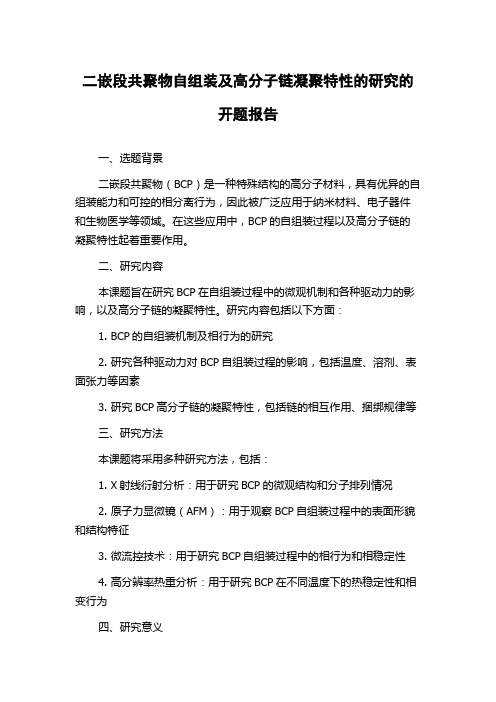
二嵌段共聚物自组装及高分子链凝聚特性的研究的
开题报告
一、选题背景
二嵌段共聚物(BCP)是一种特殊结构的高分子材料,具有优异的自组装能力和可控的相分离行为,因此被广泛应用于纳米材料、电子器件和生物医学等领域。
在这些应用中,BCP的自组装过程以及高分子链的凝聚特性起着重要作用。
二、研究内容
本课题旨在研究BCP在自组装过程中的微观机制和各种驱动力的影响,以及高分子链的凝聚特性。
研究内容包括以下方面:
1. BCP的自组装机制及相行为的研究
2. 研究各种驱动力对BCP自组装过程的影响,包括温度、溶剂、表面张力等因素
3. 研究BCP高分子链的凝聚特性,包括链的相互作用、捆绑规律等
三、研究方法
本课题将采用多种研究方法,包括:
1. X射线衍射分析:用于研究BCP的微观结构和分子排列情况
2. 原子力显微镜(AFM):用于观察BCP自组装过程中的表面形貌和结构特征
3. 微流控技术:用于研究BCP自组装过程中的相行为和相稳定性
4. 高分辨率热重分析:用于研究BCP在不同温度下的热稳定性和相变行为
四、研究意义
本课题的研究将有助于深入理解BCP的自组装过程和高分子链的凝聚特性,并为其在纳米材料、电子器件和生物医学等领域的应用提供理论依据和实验基础。
第六章 嵌段共聚物 - 同济大学材料科学与工程学院

一.嵌段共聚物的基本概念
嵌段共聚物是由化学结构和性能不同的两种或两种以上 大分子通过头尾连接所形成的共聚物,每一种大分子链的重 复单元至少早几十个以上。通常用A、B、C等来分别表示不 同单元组成的链段。因此嵌段共聚物可表示为: A-B A-B-C A-B-A (A-B)n (A-B)nX 其中,A-B表示两嵌段共聚物;A-B-C表示三嵌段共聚物, 且每一链段由不同的单体单元聚合而成;A-B-A也表示三嵌 段共聚物,但中间段为B嵌段,两端为A嵌段;(A-B)n表示 交替嵌段共聚物;(A-B)nX表示星状接枝共聚物,其臂数为 n,核心为X。 1
一大热点。
9
第八章 嵌段共聚物
二.嵌段共聚物的合成方法
从目前的情况看,嵌段共聚物基本上可分为两大类,一
类是通过活性可控聚合制备的烯烃类嵌段共聚物;另一类是 聚氨酯类嵌段共聚物。这两种嵌段共聚物的制备方法完全不 同,下面分别介绍。
10
第八章 嵌段共聚物
2.1 通过阴离子聚合制备嵌段共聚物
在各种嵌段共聚物材料中,苯乙烯嵌段共聚物型热塑性
11
第八章 嵌段共聚物
目前,聚苯乙烯—聚二烯烃—聚苯乙烯嵌段共聚物的相
畴理论已经扩展到所有 ABA型嵌段共聚物,这里A代表在使
用温度下是玻璃态或结晶态、而在高温下又可以流动的聚合 物嵌段,B代表在使用温度下是弹性态的聚合物嵌段。聚苯 乙烯 / 聚二烯烃三嵌段共聚物的研究为高分子科学开辟了一 个 新的领域。
16
第八章 嵌段共聚物
在上面的例子中,二烯烃单体的聚合反应是以 1,4 加成 形 式进行的,在惰性、非极性烃溶剂中进行聚合时,至少有 90%的单体单元是 1, 4 结构,其余是 l, 2 结构(对丁二烯而
《高分子物理》复习提纲(1)
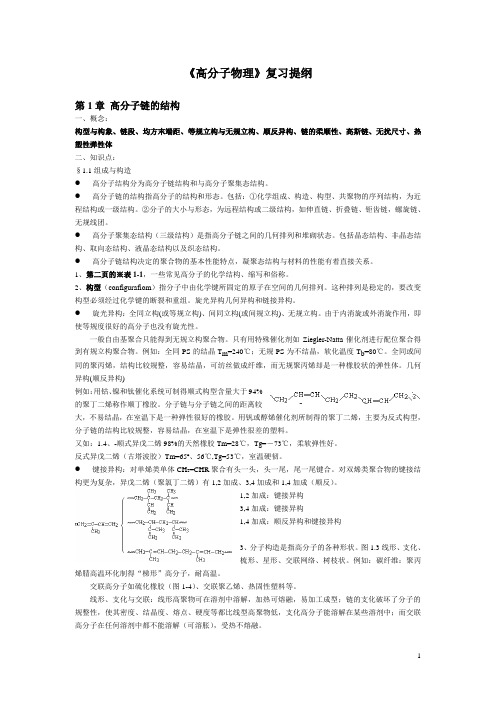
《高分子物理》复习提纲第1章高分子链的结构一、概念:构型与构象、链段、均方末端距、等规立构与无规立构、顺反异构、链的柔顺性、高斯链、无扰尺寸、热塑性弹性体二、知识点:§1.1组成与构造●高分子结构分为高分子链结构和与高分子聚集态结构。
●高分子链的结构指高分子的结构和形态。
包括:①化学组成、构造、构型、共聚物的序列结构,为近程结构或一级结构。
②分子的大小与形态,为远程结构或二级结构,如伸直链、折叠链、钜齿链,螺旋链、无规线团。
●高分子聚集态结构(三级结构)是指高分子链之间的几何排列和堆砌状态。
包括晶态结构、非晶态结构、取向态结构、液晶态结构以及织态结构。
●高分子链结构决定的聚合物的基本性能特点,凝聚态结构与材料的性能有着直接关系。
1、第二页的※表1-1,一些常见高分子的化学结构、缩写和俗称。
2、构型(configurafiom)指分子中由化学键所固定的原子在空间的几何排列。
这种排列是稳定的,要改变构型必须经过化学键的断裂和重组。
旋光异构几何异构和链接异构。
●旋光异构:全同立构(或等规立构)、间同立构(或间规立构)、无规立构。
由于内消旋或外消旋作用,即使等规度很好的高分子也没有旋光性。
一般自由基聚合只能得到无规立构聚合物。
只有用特殊催化剂如Ziegler-Natta催化剂进行配位聚合得到有规立构聚合物。
例如:全同PS的结晶T m=240℃;无规PS为不结晶,软化温度T b=80℃。
全同或间同的聚丙烯,结构比较规整,容易结晶,可纺丝做成纤维,而无规聚丙烯却是一种橡胶状的弹性体。
几何异构(顺反异构)例如:用钴、镍和钛催化系统可制得顺式构型含量大于94%的聚丁二烯称作顺丁橡胶。
分子链与分子链之间的距离较大,不易结晶,在室温下是一种弹性很好的橡胶。
用钒或醇烯催化剂所制得的聚丁二烯,主要为反式构型,分子链的结构比较规整,容易结晶,在室温下是弹性很差的塑料。
又如:1.4、-顺式异戊二烯98%的天然橡胶Tm=28℃,Tg=-73℃,柔软弹性好。
高分子材料结构与性能。

以丁二烯的聚合物为例: 顺式 为弹性体
CH2=CH-CH=CH2
反式为塑料
(2)旋光异构体
碳原子的四个价键形成正 四面体结构,键角都是 109°。
化合物分子中的异构 碳原子与四个不同的原子 相连时,这个化合物的空 间可能有两个不同排列,两 个分子在空间不能重叠它 们并不是同一种化合物。
这种性质称为“手 性”,中心的碳原子称为 “不对称碳原子”。
元素有机大分子
聚丙烯(PP)
CH2—CH—CH 2—CH
CH3
CH3
聚甲醛(POM)
CH2—O—CH 2—O—CH 2—O
2. 结构单元的连接方式
是指结构单元在高分子链中的联结方式(顺序)
完全对称的单体(乙烯,四氟乙烯),只有一种链接方式 带有不对称取代基的单烯类单体(CH2=CHR)聚合生成高 分子时,结构单元的键接方式则可能有头—头连接、头—尾 连接、尾—尾连接三种不同方式:
成为沿流动方向平行排列的伸展状态,在适当的条件下结晶而 成。分子链取向与纤维轴平行。
聚合物串晶是一种类似于串珠式的多晶体。在切应力作用 下结晶得到串晶。
a
a
b
c
e
d
二、聚合物的晶态结构模型
聚合物晶态结构模型有两种: 缨状胶束模型:认为结晶聚合物中晶区与非晶区互相穿插, 同时存在。在晶区分子链相互平行排列成规整的结构,而在非 晶区分子链的堆砌完全无序。该模型也称两相结构模型。
?1数均分子量?数均分子量被定义为在一个高聚物体系中高聚物的数均分子量被定义为在一个高聚物体系中高聚物的总重量以克为单位除以高聚物中所含各种大小分子的以克为单位除以高聚物中所含各种大小分子的总摩尔数即数均分子量是高聚物体系中各种分子量的数均分子量是高聚物体系中各种分子量的摩尔分数与其相应的分子量的乘积所得的总和
高分子物理复旦大学chapter1-2导言与高分子的大小和形状-文档资料
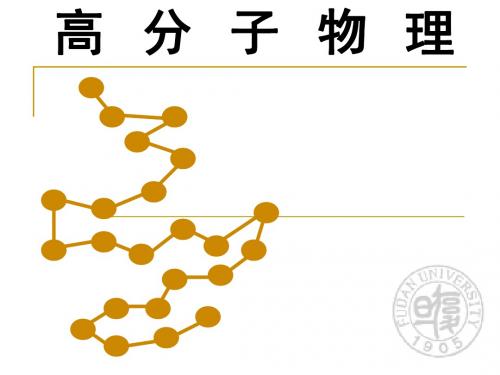
第二章 高分子的大小和形状
Primary (一级): Secondary (二级): Tertiary (三级): Quaternary (四级):
第二章 高分子的大小和形状
2.1 近程结构 (local)
-CH2-CH2-
局部的化 学结构 2.1.1 构造 (Constitutions or Architectures) 2.1.1.1 结构单元的化学组成 2.1.1.2 键接结构 2.1.1.3 支化与交联
2.1.2 构型(Configurations)
化学键固定的原子在空间的几何排列 改变构型(顺反和旋光)必须打断化学 键!!!
2.2 远程结构 (glouble)
一根链整体的形状和大小
2.2.1 高分子链的质量
长度平均-数均分子量(number averaged)
Mn
n M w n w M
模型的局限性几何统计方法的局限性412242理想高分子链模型的概率统计方法422242以理想高分子链末端距h为变量的概率分布函数对于单个键矢量的概率分布函数rr某一构象组合态43满足末端距满足末端距rr的自由连接链的概率分的自由连接链的概率分布函数布函数ffrrnnrrnnrrnn11链节的空间坐标链节的空间坐标末端矩矢量末端矩矢量44fourierftiftiftkrkrsindexpkl47满足末端距满足末端距rr的自由连接链的概率分的自由连接链的概率分布函数布函数ffrr2222sinklklnklklexpexpaxbxdx48概率分布函数概率分布函数ffrrnn的物理意义的物理意义满足末端矩满足末端矩rr的自由连接链的概率分布函数的自由连接链的概率分布函数ffrrnnpath无规行走randomwalk49只考虑末端距长度不考虑方向的只考虑末端距长度不考虑方向的wwhh概率密度高斯分布ffrrnn径向分布50末端距分布函数末端距分布函数ffrrnn的应用的应用32hhnlnlh2n31251idealpolymerchain高斯链gaussianchain或理想链idealchain末端距满足高斯分布无限长的自由连接链无规飞行链randomwalk不同程度的刚性旋转不自由excludedvolumeeffect自避行走链selfavoidingwalkrealpolymerchain链节链节有相互作用链节溶剂分子有相互作用65saw52whendoesfreelyjointedchainworks等效自由连接链coarsegrained降低高分子链的分辨率消除局部的刚性和旋转的不自由将链重新划分成有效链节数nchainheadchainend调节溶剂链节的作用屏蔽掉体积排除效应和链节链节相互作用达到q温度的溶液测得无扰尺寸hmax链的轮廓长度contourlength53penele实验测得pe
高分子物理名词解释
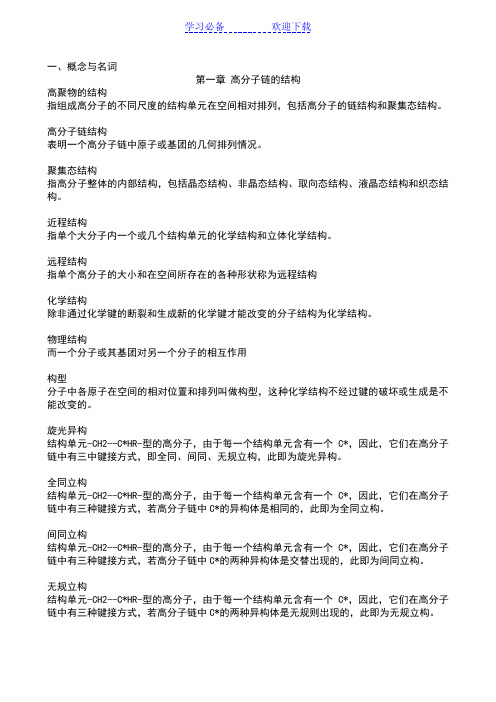
一、概念与名词第一章高分子链的结构高聚物的结构指组成高分子的不同尺度的结构单元在空间相对排列,包括高分子的链结构和聚集态结构。
高分子链结构表明一个高分子链中原子或基团的几何排列情况。
聚集态结构指高分子整体的内部结构,包括晶态结构、非晶态结构、取向态结构、液晶态结构和织态结构。
近程结构指单个大分子内一个或几个结构单元的化学结构和立体化学结构。
远程结构指单个高分子的大小和在空间所存在的各种形状称为远程结构化学结构除非通过化学键的断裂和生成新的化学键才能改变的分子结构为化学结构。
物理结构而一个分子或其基团对另一个分子的相互作用构型分子中各原子在空间的相对位置和排列叫做构型,这种化学结构不经过键的破坏或生成是不能改变的。
旋光异构结构单元-CH2--C*HR-型的高分子,由于每一个结构单元含有一个C*,因此,它们在高分子链中有三中键接方式,即全同、间同、无规立构,此即为旋光异构。
全同立构结构单元-CH2--C*HR-型的高分子,由于每一个结构单元含有一个C*,因此,它们在高分子链中有三种键接方式,若高分子链中C*的异构体是相同的,此即为全同立构。
间同立构结构单元-CH2--C*HR-型的高分子,由于每一个结构单元含有一个C*,因此,它们在高分子链中有三种键接方式,若高分子链中C*的两种异构体是交替出现的,此即为间同立构。
无规立构结构单元-CH2--C*HR-型的高分子,由于每一个结构单元含有一个C*,因此,它们在高分子链中有三种键接方式,若高分子链中C*的两种异构体是无规则出现的,此即为无规立构。
有规立构全同和间同立构高分子统称为有规立构。
等规度全同立构高分子或全同立构高分子和间同立构高分子在高聚物中的百分含量。
几何异构当主链上存在双键时,而组成双键的两个碳原子同时被两个不同的原子或基团取代时,即可形成顺反异构,此即为几何异构。
顺反异构当主链上存在双键时,而组成双键的两个碳原子同时被两个不同的原子或基团取代时,即可形成顺反异构,此即为几何异构。
高分子物理-名词解释

真题回转半径特征黏度(数)亚稳相分离不良溶剂亚浓溶液原力显微镜非牛顿流体交联嵌段共聚物聚电解质第一章高分子链的结构链结构:指单个分子的结构和形态。
近程结构(一级结构):包括化学组成、结构单元间接方式、支化、交联、构型(包括几何异构和旋光异构)远程结构(二级结构):包括高分子链的大小(相对分子质量、均方末端距、均方回转半径)和高分子链的形态(柔顺性、构象)聚集态结构(三级结构):通过范德华力和氢键形成具有一定规则排列的聚集态结构。
包括晶态、非晶态、取向态、液晶态、织态。
近程相互作用:分子链内非键合原子质检电子云的相互或排斥作用远程相互作用:因柔性高分子链弯曲所导致的沿分子链远距离的原子或基团之间的空间相互作用无扰链:只受近程相互作用不受远程相互作用的高分子链构象:由于σ单键内旋转而产生的分子在空间的不同形态。
包括顺式构象、偏式构象、反式构象、左旁氏构象、右旁氏构象。
构型:是指分子中由化学键所固定的原子在空间的排列。
构造:是指链中原子的种类和排列,取代基和端基的种类单体单元的排列顺序,支链的类型和长度等。
几何异构(顺反异构):由于主链双键的碳原子上的取代基不能绕双键旋转,当组成双键的两个碳原子同时被两个不同的原子或基团取代时,即可形成顺式、反式两种构型,它们称作几何异构。
键接异构(顺序异构):是指结构单元在高分子链中的连接方式。
旋光异构:具有不对称C原子的这种有机物,能构成互为镜象的两种异构体,表现出不同的旋光性,称为旋光异构体。
但是含不对称C的高分子没有旋光性的,原因是多个不对称C原子的内消旋或外消旋的作用。
有规立构:有两种旋光异构单元完全是全同立构或间同立构的高分子。
全同立构:高分子链全部由一种旋光异构单元键接而成。
取代基排列在同一侧,无旋光性间同立构:高分子链由两种旋光异构单元交替键接而成。
取代基交替排列,有旋光性无规立构:高分子链由两种旋光异构单元无规键接而成。
取代基无规排列,有旋光性交联:高分子链之间通过支链联结成一个三维空间网状大分子,交联高分子不溶不熔,交联度较小时可溶胀交联度:用相邻两个交联点之间的链的平均分子量Mc来表示。
材料学名词解释
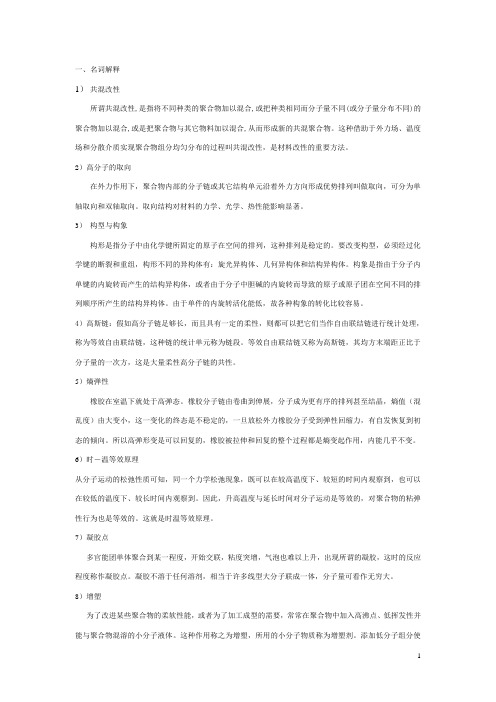
一、名词解释1)共混改性所谓共混改性,是指将不同种类的聚合物加以混合,或把种类相同而分子量不同(或分子量分布不同)的聚合物加以混合,或是把聚合物与其它物料加以混合,从而形成新的共混聚合物。
这种借助于外力场、温度场和分散介质实现聚合物组分均匀分布的过程叫共混改性,是材料改性的重要方法。
2)高分子的取向在外力作用下,聚合物内部的分子链或其它结构单元沿着外力方向形成优势排列叫做取向,可分为单轴取向和双轴取向。
取向结构对材料的力学、光学、热性能影响显著。
3)构型与构象构形是指分子中由化学键所固定的原子在空间的排列,这种排列是稳定的。
要改变构型,必须经过化学键的断裂和重组,构形不同的异构体有:旋光异构体、几何异构体和结构异构体。
构象是指由于分子内单键的内旋转而产生的结构异构体,或者由于分子中胆碱的内旋转而导致的原子或原子团在空间不同的排列顺序所产生的结构异构体。
由于单件的内旋转活化能低,故各种构象的转化比较容易。
4)高斯链:假如高分子链足够长,而且具有一定的柔性,则都可以把它们当作自由联结链进行统计处理,称为等效自由联结链,这种链的统计单元称为链段。
等效自由联结链又称为高斯链,其均方末端距正比于分子量的一次方,这是大量柔性高分子链的共性。
5)熵弹性橡胶在室温下就处于高弹态。
橡胶分子链由卷曲到伸展,分子成为更有序的排列甚至结晶,熵值(混乱度)由大变小,这一变化的终态是不稳定的,一旦放松外力橡胶分子受到弹性回缩力,有自发恢复到初态的倾向。
所以高弹形变是可以回复的,橡胶被拉伸和回复的整个过程都是熵变起作用,内能几乎不变。
6)时-温等效原理从分子运动的松弛性质可知,同一个力学松弛现象,既可以在较高温度下、较短的时间内观察到,也可以在较低的温度下、较长时间内观察到。
因此,升高温度与延长时间对分子运动是等效的,对聚合物的粘弹性行为也是等效的。
这就是时温等效原理。
7)凝胶点多官能团单体聚合到某一程度,开始交联,粘度突增,气泡也难以上升,出现所谓的凝胶,这时的反应程度称作凝胶点。
嵌段聚合物热塑性弹性体的结晶结构与性能

20 0 1年 5月
高 分 子 材 料 科 学 与 工 程
P OIYM E M ATERI I CI R A S ENCE AND NG I S E NEERI NG
v17 0 。1N_ ., 3
Ma 0 1 v2 0
嵌 段 聚 合 物 热 塑 性 弹 性 体 的结 晶结 构 与 性 能
个 T4 硬 段 形 成 了 尺 寸 更 大 的 片 晶 。 T 对应 实 际 测 得 的 更 高 的 熔 点
3 嵌 段 聚 合 物 热 塑 性 弹 性 体 的 化 学 组 分 与 结
晶 结 构 及 性 能 的 关 系
长 均 一分 布 的 聚 氨 酯较 硬段 多 分 散 分 布 的聚 氨
醋 有 更 高 的 熔 点 、 高 的 模 量 , 且 在 高 弹 区 更 而
E =
嚣
I
Fg 2 D C c re f h U i S u v so t eP
2 嵌 段 聚 台 物 热 塑 性 弹 性 体 结 晶 结 构 的 研 究
方 法
2 1 差 示 扫 描 量 热 法 ( C) . DS
Fi 3 Lang s aci g p ng. L s t e I; S f c i v h I L ra ton 1 ̄ PTM O
W di n 对 n l s a NT6 "一 2 1 ) 酰胺 酯 ( ~ ቤተ መጻሕፍቲ ባይዱ聚 2
ma s t r
在 对 聚 酰 胺 酯 T4 P T—TMO 体 系 的 研
究 中 也 发 现 硬 段 均 一 链 长 的 聚 酰 胺 酯 其 G 在 高 弹 区域 较 宽 广 的 温 度 范 围 内 几 乎 恒 定 不 变 , 显出均一硬段链长结晶的稳定性。
嵌段共聚物均聚物纳米棒自组装
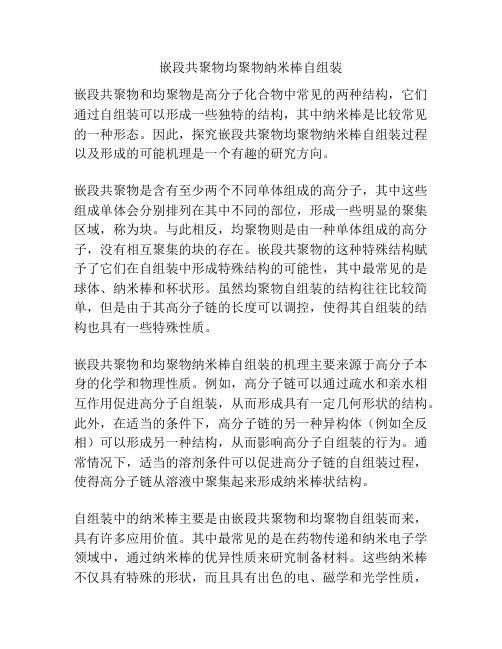
嵌段共聚物均聚物纳米棒自组装
嵌段共聚物和均聚物是高分子化合物中常见的两种结构,它们通过自组装可以形成一些独特的结构,其中纳米棒是比较常见的一种形态。
因此,探究嵌段共聚物均聚物纳米棒自组装过程以及形成的可能机理是一个有趣的研究方向。
嵌段共聚物是含有至少两个不同单体组成的高分子,其中这些组成单体会分别排列在其中不同的部位,形成一些明显的聚集区域,称为块。
与此相反,均聚物则是由一种单体组成的高分子,没有相互聚集的块的存在。
嵌段共聚物的这种特殊结构赋予了它们在自组装中形成特殊结构的可能性,其中最常见的是球体、纳米棒和杯状形。
虽然均聚物自组装的结构往往比较简单,但是由于其高分子链的长度可以调控,使得其自组装的结构也具有一些特殊性质。
嵌段共聚物和均聚物纳米棒自组装的机理主要来源于高分子本身的化学和物理性质。
例如,高分子链可以通过疏水和亲水相互作用促进高分子自组装,从而形成具有一定几何形状的结构。
此外,在适当的条件下,高分子链的另一种异构体(例如全反相)可以形成另一种结构,从而影响高分子自组装的行为。
通常情况下,适当的溶剂条件可以促进高分子链的自组装过程,使得高分子链从溶液中聚集起来形成纳米棒状结构。
自组装中的纳米棒主要是由嵌段共聚物和均聚物自组装而来,具有许多应用价值。
其中最常见的是在药物传递和纳米电子学领域中,通过纳米棒的优异性质来研究制备材料。
这些纳米棒不仅具有特殊的形状,而且具有出色的电、磁学和光学性质,
可以被用于开发各种先进的纳米材料和器件。
总而言之,嵌段共聚物和均聚物纳米棒自组装在科学和技术中具有广泛的应用前景,并且自组装的机理也是一个值得深入探究和研究的热门领域。
高分子结构的层次

高分子结构的层次:表1-1高分子的结构层次及其研究内容第1章高分子链的结构1.1组成和构造按化学组成不同聚合物可分成下列几类:1、碳链高分子(C)分子链全部由碳原子以共价键相连接而组成,多由加聚反应制得。
如:聚苯乙烯(PS)、聚氯乙烯(PVC)、聚丙烯(PP)、聚丙烯腈(PAN)、聚甲基丙烯酸甲酯PMMA。
2、杂链高分子(C、O、N、S)分子主链上除碳原子以外,还含有氧、氮、硫等二种或二种以上的原子并以共价键相连接而成。
由缩聚反应和开环聚合反应制得。
如:聚酯、聚醚、聚酰胺、聚砜。
POM、PA66(工程塑料)PPS、PEEK。
3、元素高分子(Si、P、Al等)主链不含碳原子,而由硅、磷、锗、铝、钛、砷、锑等元素以共价键结合而成的高分子。
侧基含有有机基团,称作有机元素高分子,如:有机硅橡胶。
侧基不含有机基团的则称作无机高分子。
梯形和双螺旋型高分子,分子的主链不是一条单链而是像“梯子”和“双股螺线”那样的高分子链。
第1章高分子链的结构 1.1组成和构造 1.1.2高分子的构型构型(configurafiom):指分子中由化学键所固定的原子在空间的几何排列。
这种排列是稳定的,要改变构型必须经过化学键的断裂和重组。
1、旋光异构(空间立构)饱和碳氢化合物分子中的碳,以4个共价键与4个原子或基团相连,形成一个正四面体,当4个基团都不相同时,该碳原子称作不对称碳原子,以C*表示,这种有机物能构成互为镜影的两种异构体,d型、l型,表现出不同的旋光性,称为旋光异构体。
高分子链节都有两种旋光异构体。
高分子中不关心具体的构型,只关心构型的异同。
由于内、外消旋的作用,高分子无旋光性,但旋光异构带来结构的差别。
共有三种键接方式:全同立构(或等规立构):当取代基全部处于主链平面的一侧或者说高分子全部由一种旋光异构单元键接而成。
间同立构(或间规立构):取代基相间的分布于主链平面的二侧或者说两种旋光异构单元交替键接。
无规立构:当取代基在平面两侧作不规则分布或者说两种旋光异构体单元完全无规键接时。
- 1、下载文档前请自行甄别文档内容的完整性,平台不提供额外的编辑、内容补充、找答案等附加服务。
- 2、"仅部分预览"的文档,不可在线预览部分如存在完整性等问题,可反馈申请退款(可完整预览的文档不适用该条件!)。
- 3、如文档侵犯您的权益,请联系客服反馈,我们会尽快为您处理(人工客服工作时间:9:00-18:30)。
Home Search Collections Journals About Contact us My IOPscienceThe standard Gaussian model for block copolymer meltsThis content has been downloaded from IOPscience. Please scroll down to see the full text.2002 J. Phys.: Condens. Matter 14 R21(/0953-8984/14/2/201)View the table of contents for this issue, or go to the journal homepage for moreDownload details:IP Address: 159.226.25.117This content was downloaded on 02/09/2015 at 02:29Please note that terms and conditions apply.I NSTITUTE OF P HYSICS P UBLISHING J OURNAL OF P HYSICS:C ONDENSED M ATTER J.Phys.:Condens.Matter14(2002)R21–R47PII:S0953-8984(02)17948-3TOPICAL REVIEWThe standard Gaussian model for block copolymer meltsM W MatsenPolymer Science Centre,University of Reading,Whiteknights,Reading RG66AF,UKReceived29August2001,infinal form12November2001Published13December2001Online at /JPhysCM/14/R21AbstractAs a result of important advances over the last decade,block copolymer meltshave become an excellent model system for studying fundamental phenomenaassociated with molecular self-assembly.During this time,good quantitativeagreement has been achieved between theory and experiment in regards toequilibrium phase behaviour,and with it has emerged a thorough understandingin terms of simple intuitive explanations.The theoretical contributions to thiseffort are largely attributed to mean-field calculations on a standard Gaussianmodel.Here,we review this present understanding of block copolymerphase behaviour,the model and its underlying assumptions,the mean-fieldapproximation and its limitations,and the attempts to incorporatefluctuationcorrections.Rather than following the traditional rigorous derivations,wepresent slightly more intuitive and transparent ones in such a way to stressthe close connection between the related calculations.In this way,we hope toprovide a valuable introduction to block copolymer theory.1.IntroductionThefield of complex liquids attracts tremendous attention,not only because of its rich and intriguing phase behaviour,but also because of its commercial and biological importance. These special liquids encompass a diverse range of molecular systems,typically involving molecules with two ends that interact unfavourably.In order to minimize unfavourable contacts,the molecules tend to self-assemble into ordered microstructures often with very elaborate geometries.By cleverly manipulating this tendency,researchers have created a large host of important applications.Of course,biology has taken advantage of such mechanisms from the very beginning of life.In order to study the phenomena associated with molecular self-assembly,researchers have focused much of their attention on model systems referred to as lyotropic liquid crystals,often involving simple aqueous solutions of either surfactant or lipid molecules[1].However,more recently,it has become apparent that block copolymer melts,in many ways,provide a superior system for such studies[2].0953-8984/02/020021+27$30.00©2002IOP Publishing Ltd Printed in the UK R21R22M W MatsenA polymer is any molecule constructed by linking together chemical units or monomers to form a long-chain molecule.The molecule is called a homopolymer if all the monomers are identical,whereas it is called a copolymer if it involves two or more chemically distinct monomers.If in the latter case the like monomers are grouped together in long sequences(i.e. blocks),the molecule is termed a block copolymer.There exists an endless variety of block copolymer architectures,which can be studied in either the pure form or as blends.Naturally, research begins with the simplest model system,just as the study of atomic physics begins with the hydrogen atom.In this case,the most basic system is the pure AB diblock copolymer melt,where the molecule is composed of just two sequential blocks denoted A and B.For theoretical purposes,it is advantageous to group monomers together into larger units calledsegments,each with the same specified volume,ρ−10.The AB diblock copolymer is thencharacterized by its total number of such segments,N,and the fraction,f,of those that are of type A.Block copolymer melts are blessed with a number of distinct advantages over small-molecule lyotropic systems.For example,the macromolecular nature of polymers suppresses effects related to the atomic details,providing systems where the behaviour is more universal and dependent upon far fewer parameters.In particular,high-molecular-weight polymers can be accurately modelled as Gaussian chains,where they are represented by smooth space curves with a simple stretching energy to treat their local configurational entropy,and the molecular interactions between A and B segments can be represented by a single Flory–Hugginsχparameter.Furthermore,the macromolecular character suppressesfluctuation effects,which tend to obscure the underlying mechanisms responsible for molecular self-assembly.The absence offluctuations also implies that mean-field results are accurate.This has been particularly valuable now that new advances in self-consistentfield theory(SCFT)[3,4]permit exact mean-field calculations for arbitrarily complex ordered microstructures[5].When the incompatibility of unlike segments,as determined by the product,χN,becomes sufficient,the segments segregate into A-and B-rich domains forming periodically ordered microstructures like those depicted infigure1.Amazingly,these structures are virtually identical to those of the conventional lyotropic systems[1].The simplest and most common classical microstructures,include the lamellar(L)phase in which the domains form alternating flat layers,the cylindrical(C)phase where the minority component forms cylinders packed on a hexagonal lattice,and the spherical(S)phase where the minority blocks form spheres arranged on a bcc lattice.We will also discuss the variation where the spheres occur on a close-packed lattice(S cp).The molecular self-assembly also produces more complex microstructures,the most common being the gyroid(G)phase where the minority domain forms two interweaving three-fold coordinated lattices[6,7].Experiments have also identified a perforated-lamellar(PL)phase similar to the classical L phase,but with a hexagonal arrangement of perforations in the thinner minority layers through which the majority layers are connected[8].For neat diblock copolymer melts,this state is only metastable and eventually converts to the G phase after sufficient annealing[9,10].Another structure occasionally observed in conventional lyotropics is the double-diamond(D)phase similar to G,but where the interweaving lattices are four-fold coordinated[1].However,this structure is absent from the neat diblock system[11].Figure2compares the mean-field phase diagram[12]for diblock copolymers to experiment[13–15]1.Despite the clear similarities,there are some significant differences.The qualitative differences along the order–disorder transition(ODT)are attributed tofluctuation 1The experimental PS–PI phase diagram infigure2(b)has been revised from the original[13–15]by interpreting PL as a metastable state that eventually converts to G after sufficient annealing[9].The standard Gaussian model for block copolymer melts R23Figure1.Schematic illustrations of six ordered morphologies showing the domains occupied bythe smaller minority blocks.The morphologies can be subdivided into the classical lamellar(L),cylindrical(C)and spherical(S)phases,and the complex gyroid(G),perforated-lamellar(PL)anddouble-diamond(D)phases.The expanded view of the L phase demonstrates the self-assembly ofindividual molecules within the morphology.effects omitted by the mean-field calculation[16].The experimental diagram also possesses a small degree of asymmetry about f=0.5,which is partly accounted for by the asymmetry in the A and B statistical segment lengths[17].Naturally,some of the differences can be attributed to the standard Gaussian model,but we should also acknowledge a significant degree of experimental inaccuracy infigure2(b)due to nonequilibrium effects,uncertainties in molecular characteristics,impurities,etc.Considering all this,the theory is,in fact,rather successful. Most importantly,the theory has contributed greatly to our fundamental understanding of these molecules by providing simply intuitive explanations for the qualitative features of the phase diagram,including the absence of the D and PL phases.The present literature already contains a number of valuable reviews[12,13,18–22] and books[23–25]on block copolymer systems.This review aims to compliment them by providing an introduction to block copolymer theory in the context of the simple diblock copolymer melt.The task of doing so is greatly simplified by the fact that researchers have,in most part,embraced a single standard model.The success of this model can be attributed to its microscopic origin combined with the coarse-graining that buries the complications associated with treating atomic details.Section2provides a complete description of the model and justifies the underlying assumptions.Despite its simplicity,the fact that the model considers individual molecules renders an exact statistical mechanical treatment untractable.Fortunately, the suppression offluctuations in polymeric systems permits accurate results to be obtained using the mean-field method.Section3describes the exact numerical implementation of mean-field theory as well as analytic approximations for both weakly and strongly segregated melts. We present these in a unified framework opting for slightly more intuitive derivations over the more traditional rigorous ones.From the theory,there emerge simple intuitive explanations for block copolymer phase behaviour,to which we devote section4.Although reasonably accurate,the mean-field results are modified byfluctuation effects discussed in section5.The review concludes with section6discussing some of the outstanding problems facing the future progress of block copolymer research.R24M W Matsen f0.00.20.40.60. 1.08χN 010203040χN 010203040Figure 2.(a)Theoretical and (b)experimental equilibrium phase diagrams calculated using SCFTand measured using polystyrene –polyisoprene diblock copolymers.In (a),the solid dot denotesthe mean-field critical point and the vertical arrows indicate the L/C and C/S phase boundaries aspredicted by SST.In (b),the solid dots denote the experimental data points,while the curves serveonly as a guide to the eye.Plots (a)and (b)are adapted from [12]and [13–15],respectively.2.ModelIt is immensely convenient that block copolymer theory has largely evolved around a common standard model,particularly as this allows easy comparison between distinct calculations.The chosen model considers the individual molecules,but ignores their atomic structure as this is irrelevant to the mesoscale behaviour of the melt.The wide spread use of this coarse-grained microscopic model has resulted due to its combination of simplicity and validity.Here,we describe it for a melt of n identical AB diblock copolymer molecules,each with N segments of which a fraction f forms the A block.To specify their con figurations,each molecule is parametrized by a variable s than increases continuously from 0to 1along its length.The con figuration of the αth molecule is then represented by a simple mathematical space curve,r α(s).Given this de finition,the concentrations of A and B segments at a given point r areˆφA (r )=N ρ0n α=1 f 0δ(r −r α(s))d s (1)ˆφB (r )=N ρ0n α=1 1fδ(r −r α(s))d s (2)respectively.These concentrations are made dimensionless by dividing by the average segment density,ρ0.Although ˆφA (r )and ˆφB (r )are highly discontinuous functions,owing to the fact that the polymers are treated as in finitely thin threads,their ensemble averages,φA (r )≡ ˆφA (r ) (3)φB (r )≡ ˆφB (r ) (4)The standard Gaussian model for block copolymer melts R25B Figure 3.Schematic diagram showing the molecular self-assembly within the lamellar (L)phase with the corresponding ensemble-averaged segment distributions,φA (r )and φB (r ).Figure 4.Diagram of a semi flexible worm-like chainwith the space curve,r α(s),specifying its trajectory relative to some arbitrary origin,O,and the unit vector,u α(s),specifying its local orientation.In this model,the chain has a fixed length,bN ,and a bending rigidity,κ,that keeps it relatively straight over a persistence length,ξ=bκ.BFigure 5.Diagram of a flexible Gaussian chain with the space curve,r α(s),specifying its trajectory relative to some arbitrary origin,O.In this model,a coarse-grained segment represents a coil of chain,and thus its length,l ,can vary.However,the entropyof a segment decreases as it stretches,resulting in a free energypenalty that causes the segment to mimic an ideal spring.are well-behaved continuous functions.These average concentrations are plotted for the lamellar (L)phase in figure 3.2.1.IncompressibilityMolecular interactions are typically separated into a short-range hard-core repulsion and a long-range attraction.The primary effect of the hard-core component is to prevent the molecules from overlapping,which is responsible for the near incompressibility of a liquid.Indeed,high-pressure experiments [26]on block copolymer melts have demonstrated a negligible compressibility.This fact permits us to simplify the model by imposing an incompressibilityR26M W Matsenassumption,ˆφA(r)+ˆφB(r)=1(5) in place of the hard-core interactions.Of course,we cannot strictly enforce such an incompressibility if we treat the molecules as infinitely thin threads,but it can be enforced on all length scales down to some microscopic cutoff.Nevertheless,this issue becomes irrelevant in mean-field theory,because the theory is only capable of constraining the ensemble-averaged concentrations,i.e.φA(r)+φB(r)=1.(6) 2.2.Segment interactionsGiven the incompressibility assumption,the model only needs to consider the attractive portion of the interaction.Although this part of the interaction is long-range relative to the hard-core part,it is nevertheless short-range compared to the dimensions of any microstructure within the melt.Therefore,the attractions can be treated by simple contact forces.In a small volume, d r,located at r,the number of A/B segment contacts is assumed to be proportional to the product,ˆφA(r)ˆφB(r)d r.Hence,the total internal energy of the melt isˆU k B T =χρ0ˆφA(r)ˆφB(r)d r(7)whereχis a proportionality constant that varies with temperature.The thermal energy k B T and segment densityρ0are included to makeχdimensionless.Note that there is no need to include analogous integrals for the A/A and B/B segment interactions provided the melt is treated as incompressible,because the incompressibility condition can be used to reexpress each of them as an irrelevant constant plus an integral equivalent to the above.2.3.Semiflexible worm-like chainThe last consideration is the internal energy of the polymer chain.Rather thanfirst discussing the simple Gaussian model upon which most calculations are based,we begin with a slightly more complicated but more realistic and intuitive model known as the worm-like chain[27–30]. In this model,each segment has afixed contour length,b,and afinite bending rigidity,κ.The bending energy of the polymer backbone over an interval,s1<s<s2,is given by the integral,ˆE b[rα(s);s1,s2]k B T =κ2Ns2s1|u α(s)|2d s(8)where uα(s)≡r α(s)/bN is the unit vector tangent to the chain as indicated infigure4. Clearly,a large bending rigidityκsuppresses variations in uα(s)or,in other words,opposes bending.The persistence length over which the chain remains relatively straight is given by ξ=bκ.Thus,by tuningκ,this model can span continuously between the rigid-rod limit (ξ bN)and theflexible-chain limit(ξ bN)characteristic of high-molecular-weight polymers.Note that,if one wishes to assign distinct contour lengths,b A and b B,or distinct bending rigidities,κA andκB,to the A and B segments,respectively,it is just a simple matter of splitting the integral(8)for s<f and s>f.2.4.Flexible Gaussian chainAlthough manageable,the worm-like chain model is unnecessarily complicated when considering high-molecular-weight polymers whereξ bN.If we letξ→0and b→∞The standard Gaussian model for block copolymer melts R27 while at the same time(2ξb)1/2approaches afinite value,a,we end up with the Gaussian chain model.The value a is referred to as the statistical segment length,and is effectively the RMS end-to-end length of a unperturbed segment.Provided that the segment profiles,φA(r)andφB(r),vary slowly relative to the persistence length,ξ,the Gaussian model is equivalent to the worm-like model but much simpler to apply.One small difficulty with letting the persistence length approach zero is that the polymer trajectory becomes extremely erratic making it impossible to specify the chain orientation.To cope with this,the space curves,rα(s),are redefined as smooth coarse-grained paths through the N segments of the chain as infigure5.On this scale,the segments appear relatively straight as in the worm-like chain model,but now their length,l,can vary due to their internal coil-like structure.However,as an individual coarse-grained segment stretches,the number of available internal configurations decreases.The corresponding drop in entropy produces a free energy penalty that opposes the stretching.In fact,the entropic free energy increases as l2,and hence a Gaussian segment behaves equivalently to an ideal spring[31].The total stretching energy for a given interval,s1<s<s2,of the chain isˆE st[rα(s);s1,s2]k B T =32Na2s2s1|r α(s)|2d s(9)where a−2acts as a spring constant.Again,the A and B segments can be assigned distinct statistical lengths,a A and a B,respectively,by simply splitting the integral(9)into two parts[17].2.5.Extensions to the modelThe standard Gaussian model described above has dominated because of its inherent simplicity. Nevertheless,many generalizations are straightforward.For example,the internal energy can be expanded asˆU k B T =ρ0[−χˆφ2(r)+χ3ˆφ3(r)+χ4ˆφ4(r)+···]d r(10)whereˆφ(r)≡ˆφA(r)−f.The linear term is omitted because it integrates to zero,and the second-order term is written such that the expression becomes equivalent to equation(7)when χ3=χ4=···=0.The addition of higher-order terms is analogous to providing the normal Flory–Hugginsχparameter with a concentration dependence[32].Still,this expression(10) is limited to local interactions of zero range.Short-range interactions can be incorporated by supplementing the internal energy with the non-local term,ˆU nl k B T =−16χσ2ρ0|∇ˆφ(r)|2d r(11)whereσmeasures the range of the interaction[3].Realistic interactions also possess some orientational dependence.Unfortunately,a proper treatment of such nematic interactions is impossible in the Gaussian chain model,because the chain orientation is completely lost. Nevertheless,it is easily incorporated into the worm-like chain model[27].It is clear that such interactions are essential for copolymers containing liquid-crystalline units,but they may also have a significant effect in conventional block copolymer melts.The incompressibility constraint is easily relaxed[4],but this introduces additional parameters,specifically the compressibilities of the A and B segments.The versatility of the model also extends to more complex architectures,such as ABA triblocks[33],linear multiblocks[34],starblocks[35], ABC triblocks[36],etc.Furthermore,there is absolutely no difficulty in considering a blend involving various block copolymers,homopolymers,and solvents[37,38].R28M W Matsen 3.Mean-field theoryAccording to the standard Gaussian model,diblock copolymers are treated as microscopicelastic threads with two ends that interact by an unfavourable contact energy under theconstraint that they mustfill space uniformly.Despite the simplicity of this model,the statisticalmechanics required to predict the equilibrium behaviour is still complicated by the correlationsassociated with interacting molecules.To cope with this many-body problem,it is useful toreplace the interactions by thefields,ˆw A(r)=χNˆφB(r)+ˆξ(r)(12)ˆw B(r)=χNˆφA(r)+ˆξ(r)(13) representing the total interaction experienced by individual A and B test segments,respectively,at position r.In each case,thefirst term represents the attractive portion of the molecularinteractions,while the second represents the hard-core part.Of course,we have replaced thelatter interactions by the incompressibility constraint,and soˆξ(r)is actually the Lagrange-multiplierfield enforcing the constraint,but nevertheless it can be interpreted as thefield dueto hard-core interactions.Thus far,no approximations have been made.However,we are prevented from proceedingby the fact thefieldsfluctuate due to the motion of the molecules creating them.In mean-fieldtheory,this is remedied by simply time averaging(or equivalently ensemble averaging)thefield equationsw A(r)=χNφB(r)+ξ(r)(14)w B(r)=χNφA(r)+ξ(r)(15) whereξ(r)is to be determined by equation(6).The meanfields are plotted infigure6for a simple lamellar(L)phase.By appreciating that the mean-field method simply involves approximating theinstantaneousfields,ˆw A(r)andˆw B(r),by their time averages,w A(r)and w B(r),it is easy to understand its implications and limitations.For instance,mean-field theory is accurate for well-ordered microstructures since thefields are large relative to their thermalfluctuations.It is also accurate deep in the disordered region,but in this case because thefields are so weak that any approximation would do.The inaccuracies in mean-field theory are most significant near the ODT,where thefields are highlyfluctuating and sufficiently strong to affect the polymer configurations.3.1.Self-consistentfield theoryThe full mean-field theory,more commonly referred to as SCFT,wasfirst extended to block copolymers by Helfand[3,4]in1975.Here,we present an alternative derivation that is a little less rigorous but more intuitive.The essential part of SCFT is evaluating the exact equilibrium behaviour of a single diblock copolymer subjected to the meanfields,w A(r)and w B(r).The partition function for this isQ=0<s<1rα(s)exp−ˆE mf[rα(s);0,1]k B T(16)where the sum is over all space curves rα(s)with s in the interval(0,1).The energy of a molecule subjected to the meanfields is given byˆE mf[rα(s);s1,s2]k B T =s2s132Na2|r α(s)|2+w(rα(s),s)d s(17)The standard Gaussian model for block copolymer meltsR29q(r q(r,s)BFigure6.To cope with a large number of interacting molecules,mean-field theory focuses on a single molecule and represents its interactions by two static fields,w A(r)and w B(r),acting on the A and B segments, respectively.Figure7.Three representative configurations of a diblock molecule with its s segmentfixed at position r.Given that the molecule is exposed to staticfields, the energies of the two portions,(0,s)and(s,1),areuncoupled,permitting us to calculate their individualpartition functions,q(r,s)and q†(r,s),respectively.The total partition function for the constrained chain isthen the product,q(r,s)q†(r,s).Figure8.At extreme segregations,the coarse-grained trajectory of adiblock molecule is restricted to straight paths normal to the interface.Nevertheless,the molecules still exhibit a nontrivial distribution ofblock lengths,z0.where for convenience we have definedw(r,s)≡w A(r)if s<fw B(r)if f<s.(18) In order to evaluate Q,wefirst calculate the partition functionQ c(r,s)=0<t<1rα(t)exp−ˆE mf[rα(t);0,1]k B Tδ(rα(s)−r)(19)for a diblock copolymer with the s th segment constrained to position r.Since the energy of the chain can be split asˆE mf[rα(t);0,1]=ˆE mf[rα(t);0,s]+ˆE mf[rα(t);s,1](20)Q c(r,s)can be expressed as the product of two partial partition functions,q(r,s)=0<t<srα(t)exp−ˆE mf[rα(t);0,s]k B Tδ(rα(s)−r)(21)q†(r,s)=s<t<1rα(t)exp−ˆE mf[rα(t);s,1]k B Tδ(rα(s)−r)(22)as illustrated byfigure7.Thefirst,q(r,s),can be evaluated starting from q(r,0)=1anditerating withq(r,s+ε)=q(r+R,s)exp−3|R|22Na2− w(r,s)d R(23)using a sufficiently smallε.Alternatively,equation(23)can be converted to the differential equation[3],∂∂s q(r,s)=a2N6∇2q(r,s)−w(r,s)q(r,s).(24)The equation for q†(r,s)is identical,but with the right-hand side multiplied by−1.Given the partition function,Q c(r,s)=q(s,r)q†(s,r),for a constrained chain,the partition function, Q,for an unconstrained chain is evaluated by summing over all possible positions r of the s thsegment;Q=q(s,r)q†(s,r)d r.(25)As must be the case,the above integral is independent of s.The constrained partition function Q c(r,s)also serves a second purpose as it is directly proportional to the distribution of the s th segment.From this and the fact that the volume average ofφA(r)must equal f,it immediately follows thatφA(r)=VQfq(s,r)q†(s,r)d s.(26)The expression forφB(r)is identical,except that the integral extends from f to1.Because ordered block copolymer morphologies are periodic,it is most efficient to perform the above calculation using the Fourier-space algorithm developed in[5].Now that we can evaluateφA(r)andφB(r)for any given w A(r)and w B(r),the next step is to adjust thefields according to an iterative procedure2so as to satisfy the self-consistent equations(14),(15)and the incompressibility condition(6).However,there are an infinity of possible solutions,each corresponding to a different morphology.Based on experiment and our intuition,we often know which morphologies to consider,and then it is just a matter of locating their appropriate solutions.A desired solution is obtained by starting the iteration from a sensible initial guess,where the minima of w A(r)and w B(r)correspond to the expected locations of the A and B domains,respectively.In the event that not all the possible morphologies are known,a real-space screening method introduced by Drolet and Fredrickson[42]can be used to generating new candidate structures.To identify which solution represents the equilibrium morphology as well as to determine its preferred domain spacing requires the free energy,F=U−T S.In the spirit of mean-field theory,the average internal energy is approximated byU k B T =χρ0φA(r)φB(r)d r.(27)2Usually the iteration is performed by a quasi-Newton–Raphson method or by a Picard procedure as described in[39].The entropy is then obtained by taking the free energy of n diblock copolymers subjected to the mean fields,and subtracting off the energy of the fields;S k B=n ln Q +ρ0 [w A (r )φA (r )+w B (r )φB (r )]d r .(28)The theoretical phase diagram in figure 2(a)is nothing more than a map showing the morphology of lowest free energy plotted as a function of segregation χN and composition f .3.2.Weak-segregation theoryIn 1980,Leibler [43]introduced an analytical approximation to the full mean-field theory appropriate for weakly-segregated melts.This was done by deriving a Landau expansion about the disordered state,F [φ]nk B T ≈χNf (1−f )+V 2!(2π) S −1(q 1)φ(q 1)φ(−q 1)d q 1+V 23!(2π)2 3(q 1,q 2)φ(q 1)φ(q 2)φ(−q 1−q 2)d q 1d q 2+V 34!(2π) 4(q 1,q 2,q 3)φ(q 1)φ(q 2)φ(q 3)φ(−q 1−q 2−q 3)d q 1d q 2d q 3(29)to fourth-order in the Fourier transform of the concentration pro file,φ(q )=1 [φA (r )−f ]exp (i r ·q )d r .(30)The mean-field free energy,F ,of the melt is found by minimizing this functional,F [φ],with respect to the concentration pro file,φ(q ).In the limit of weakly-segregated melts,the phase behaviour is governed by the inverse scattering function,S −1(q )=F (q 2a 2N/6)−2χN(31)whereF (x)=g(1,x)/[g(f,x)g(1−f,x)−h 2(f,x)h 2(1−f,x)](32)g(s,x)=2[sx +exp (−sx)−1]/x 2(33)h(s,x)=[1−exp (−sx)]/x.(34)At low χN ,S −1(q )is positive for all q ,and therefore the disordered state (i.e.φ(q )=0)provides the lowest free energy.However,as χN increases,a spinodal curve is encountered at which point S −1(q )becomes zero on a spherical shell of radius q ∗.Beyond the spinodal curve,the quadratic term favours periodic pro files of wavelength 2π/q ∗,causing the disordered phase to become unstable.The quartic term serves to prevent the concentration modulations from diverging.The cubic term has the notable effect of causing the ordered phase (i.e.φ(q )=0)to become stable just prior to the spinodal resulting in a discontinuous ODT.The only exception is for f =0.5,where by symmetry the cubic term is absent,and consequently the ODT becomes a critical point coinciding with the spinodal curve.In the vicinity of the spinodal,the free energy is dominated by wavevectors,q ,satisfying |q |=q ∗.As a result,the only ordered structures are those with either lamellar,hexagonal (p6mm),or body-centred cubic (Im ¯3m)symmetry [44].However,beyond the spinodal,additional wavevectors become relevant allowing the formation of,for example,close-packed。
